 |
 |
Vichy, imperial spa resort |
 |
In the province of Auvergne, Vichy offers a wide range of high quality hydrotherapy treatments in a peaceful and charming old-fashioned setting. Modern thermal establishments stand along historic Art Nouveau and Art Deco buildings as well as monuments dating back from Napoleon III.
[ Practical ]
Getting there
- By road
357 km from Paris on autoroutes A6 and A77 then on roads N 7 and N 209.
- By train
Teoz train Paris Gare de Lyon – Vichy. The journey takes 2 h 50.
Lodging
Ibis hotel, linked to the Thermes Callou
Novotel Thermalia, linked to the Thermes des Dômes
Sofitel Célestins, linked to the Spa Les Célestins
Pavillon d’Enghien
Hotel de Grignan
Hotel Les Nations
Hotel Midland
Restaurants
N 3
La Brasserie du Casino
Restaurant Jacques Decoret
La Table d’Antoine
L’ Aromate
La Medina
Getting around
All the monuments are within walking distance.
Examples of price
Slimming in Vichy and Osteoarthritis Prevention 6 / 12 days : 690 € / 1212 €.
Post Natal Cure 6 days : 708 €
Discovery of Balnéotherapy 2 days : 148 €
Vichy shower : 40 €
Peeling : 52 €
Underwater massage : 52 €
Modelage : 40 €
Facial cares : 50 à 90 €
Body cares : 60 à 125 €
Information and bookings
- Allier Tourist Office
Tel : 0470468160
www.allier-tourisme.com
- Vichy Tourist Office
Tel : 0470987194
www.vichy-tourisme.com
- Vichy Thermes
Tel : 0800300063, 0470973959
www.destinationvichy.com
Like most of the French thermal towns, Vichy was founded by the Romans. They were the first to discover and to enjoy the properties of its eleven springs to cure rheumatisms, arthritis and digestive disorders. Since that time the virtues of these waters - all different in composition and in temperature - have always been renowned.
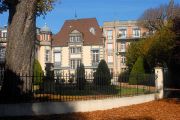
 Pavillon Sévigné © T.Joly Pavillon Sévigné © T.Joly
|
 Europe’s most esteemed spa resort Europe’s most esteemed spa resort
So numerous celebrities came there to follow thermal treatments including Louis XIV’s daughters, Napoleon I’s mother and the writer Madame de Sévigné. She was a patient in 1676 and 1677 and she popularized Vichy through the written description in her famous letters to her daughter. Thanks to the waters that were said to have cured the paralysis in her hands. But the one who did most for the town was Napoléon III who stayed there five times between 1861 and 1866. On his behalf new buildings were erected including a large casino, new streets were laid out and dykes were built along the river Allier where the marshes were drained to give place to a landscaped garden. Even more important, his visits brought worldwide fame to Vichy that became from that time one of Europe’s most esteemed spa resort. This lasted till the Second Wold War that brought bad press to the city as the government of occupied France headed by Marshall Pétain collaborated with the Germans from here.

 Callou thermal baths © Vichy Thermes Callou thermal baths © Vichy Thermes
|
 Modern thermal baths Modern thermal baths
However Vichy became once again very popular during the 50s and 60s and profited from a massive influx of French clients living in North Africa who holidayed there spending lavishly. Unfortunately the decolonisation and the rise of thalassotherapy that attracted more and more patients taking the waters marked an halt in prosperity for the city.
Nevertheless Vichy is nowadays once again one of France’s foremost spas. On one hand because the city always remained worldwide known for the quality of its cosmetic and dermatologic products as well as for its mineral water and its Vichy shower, a 4-handed massage under a delightful drizzle of lukewarm spa water. On the other hand it owes a lot to the efforts and the investments made by the Compagnie Fermière de Vichy, the company that runs the springs and the thermal baths on behalf of the State. Thus in 1990 were inaugurated the Callou thermal baths, a vast modern building dotted with 130 individual cabins, a swimming pool and a large terrace –solarium.
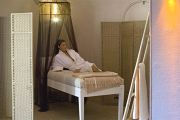
 Thermes des Dômes © Jérôme Mondière Thermes des Dômes © Jérôme Mondière
|
 Slimming in Vichy Slimming in Vichy
An establishment which is reserved for people following an hydrotherapeutic cure reimbursed by the French welfare system, the Sécurité Sociale. Lasting 18 days these cures include 72 to 108 cares depending if they aim to treat one affection (rheumatism or digestive disorder) or two. Patients can add to it other non-reimbursed cares such as underwater massages, Vichy Thermal mud wrap or intestinal shower.
For an extra fee, these cures can also be taken at the Thermes des Dômes where the patients get a more personalized and individualized treatment. Built in 1903 in a neo Moorish style, this establishment was regularly refurbished and embellished since 1990. It also offers 6 to 12 days cures to prevent osteoarthritis and back problems, for young mothers, to recover fitness and to slim. Named “Slimming in Vichy” the last one includes a 6 months post treatment follow up.
 Temple of well-being Temple of well-being
Once again “A la carte” treatments are also available such as Vichy Thermal mud wrap, multi jets baths or underwater shower, draining jet shower, underwater massage, ayurvedic modelage, relaxing modelage with hot oils, folding and rolling massage,… Besides, the premises also house a relaxation area including a swimming pool with 35°C thermal water, sauna, oriental stem room, jaccuzi and a cardio training room. Moreover a tiny snack restaurant serves dietetic dishes to take away or to eat on the spot.
Having said that, Vichy’s temple of wellbeing and relaxation is the Spa Célestins. Inaugurated in 1993 this vast building bathed with natural light immerses guests in soothing fragrances and all-encompassing melodies thus creating an atmosphere of serenity. They find there a little restaurant serving dietetic meals and a relaxation atrium open both for outside persons and patients following a treatment.
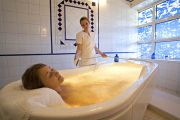
 Spa Les Célestins © Jérôme Mondière Spa Les Célestins © Jérôme Mondière
|
 Wide choice of cares Wide choice of cares
It includes a swimming pool with thermal water, a giant jacuzzi also called small swimming pool where are given aquagym sessions, an oriental stem room, a sauna, a rest room, an herbal tea room, a cardio training and a gymnastic room hosting collective courses and personalised courses. Dotted with up to date equipments individuals cabins allow a wide array of cares : toning and relaxing massages, wraps with Vichy, Auvergne or Oriental mud wraps, Vichy water bath with orange and lavender oils or with cedar and lemon oils, Vichy shower, tonic jets, whirpool baths, massages ( Californian, Ayurvedic, Swedish, whith hot volcanic stones,..) lymphatic drainage, peeling, scrubs, beauty cares, rituals,… All these cares can be taken “ A la carte” or within the frame of 2-5 days packages called “Well Being in Vichy”, “Escape to Vichy”, “Celestins Complexion” and “Golf and Spa”.
 Aesthetic institute Aesthetic institute
The Spa Celestins also provides the 6 and 12 days “Slimming in Vichy” cures and houses for this purpose a nutritional centre offering
dietary consultations, light cooking courses, conferences about cooking techniques, fridge stowage, resistance to temptation, physical exercise, and workshops on sophrology and behaviour therapy as well as to learn how to compose a meal, read labels, shop food,… All these conferences and workshops are free of charge for the patients.
Last innovation, in 2008 the Spa was enhanced with a new aesthetic institute created in partnership with the Laboratoire Vichy. It provides exclusive dermo-cosmetic treatments aimed to restore the skin beauty, has luxurious and spacious cabins and uses the latest technologies. Beauticians choose the most suitable treatment for the skin after a diagnostic made by Dermoanalyser, a new and unique appliance especially developed for that.
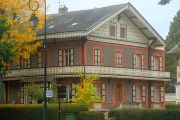
 Napoléon III's chalet © T.Joly Napoléon III's chalet © T.Joly
|
 Art Nouveau and Art Deco Art Nouveau and Art Deco
But Vichy’s charms are not limited to its springs and its thermal treatments. The city offers such a choice of tourist attractions and activities that it is a destination for everyone. First, Vichy possesses a rich architectural heritage, in particularly from Napoleon III era. It includes the two chalets built for the Emperor and his close relatives, English style bow window houses were lived his guard officers, villas and of course the superb casino theatre. Then, at the Belle Epoque, at the beginning of the 20th century, were built the Thermes des Dômes, villas, the opera, now the congresses palace,, the iron framed covered gallery that surrounds the Parc des Sources where afternoon concerts are played in a delightful bandstand and the Hall des Sources where patients can come to drink the five drinkable springs. Fashionable between the two world wars the Art Deco is represented by several hotels and the very beautiful Notre-Dame des Malades church.
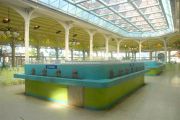
 Hall des Sources © T.Joly Hall des Sources © T.Joly
|
 An invitation to stroll An invitation to stroll
It stands in the “Vieux Vichy”, formerly the medieval town. However it remains very few buildings from that time except the Castel Franc, a 16th century court hall built over the former ramparts. That’s in this neighbourhood that are found the beautiful 17th century stone house where Madame de Sévigné stayed and the one where was born famous writer and journalist Albert Londres.
Besides, the banks of the river Allier are an invitation to stroll as well as the Napoléon III park, a 13 ha English style park made up of lawns, flower beds and trees including rare species where it is common to spot squirrels. As to those who want to do sports, they can head to the other side of the river. At the Sporting Club there are tennis and swimming, at the Yacht Club rowing, water-skiing and wind-surfing. There is also a 18 holes golf course, plus another one only 4 km away, as well as an hippodrome where are held more than 300 trotting, gallop and steeple chase races from May to September.
 Tasty dietetic meals Tasty dietetic meals
Gamblers can keep betting well into the night in two casinos but Vichy is not a place for people searching for busy nightlife. However, on the evening it offers a rich and diversified cultural program. Throughout the year the casino-theatre with its famous acoustics and ornate gilding hosts operas, ballets, song recitals, concerts and variety shows. In addition good restaurants are waiting for the gourmets. At the Sofitel Célestins hotel, the N3 offers one of the best cooking in the region. Like about ten other restaurants in town identified by the label “Saveurs, Plaisir, Santé” it serves dietetic meals conceived in partnership with the thermal establishments in order to allow the patients to eat tasty different meals each day of their treatment. In Vichy hydrotherapy combines well with gastronomy and pleasure.
June 01, 2011
Hélène Tilliette 

|
|
 |

|
 |



